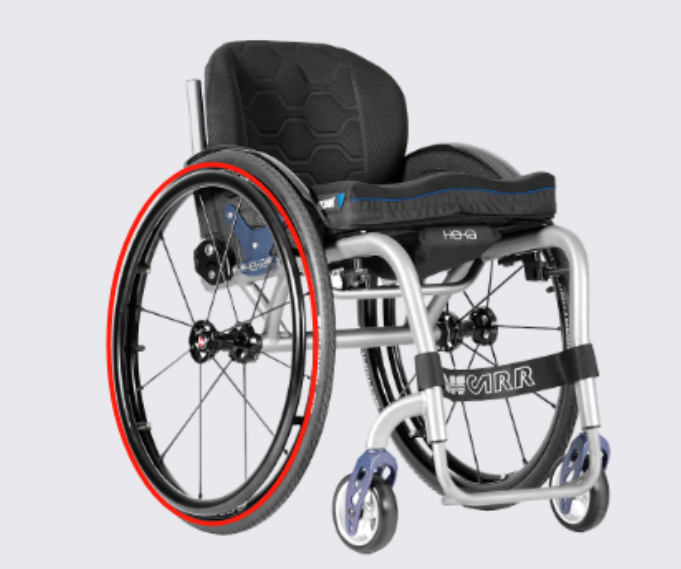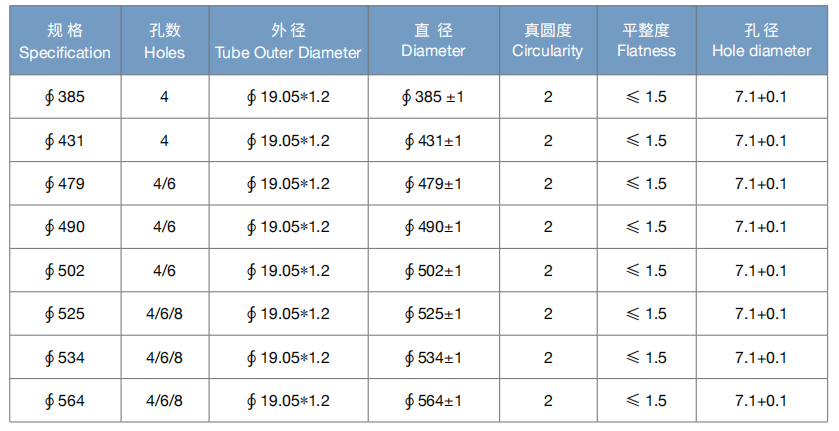Wheelchair Round Aluminum Alloy Welded Push Rim
5 month agoFor manual wheelchair users, the handrim—also known as the pushrim—is more than just a functional component; it's the primary interface between the user and their mobility device. Serving as the driving mechanism that converts arm movement into forward motion, the design, material, and customization of handrims directly impact maneuverability, comfort, and long-term usability. This article explores the technical and ergonomic advantages of circular aluminum handrims—a popular choice for their lightweight strength, customizable sizing, and user-centric design. We’ll delve into why their round cross-sectional shape, aluminum construction, and adjustable dimensions make them a preferred solution for wheelchair users of all abilities, from daily commuters to active athletes.

Handrims are cylindrical rings mounted on the outer edge of wheelchair wheels, allowing users to propel, steer, and brake by applying force with their hands. A well-designed handrim must balance several key factors:
Ergonomics: Comfortable grip to reduce strain on hands, wrists, and shoulders
Durability: Resistance to wear and tear from daily use and environmental factors
Maneuverability: Precise control for navigating tight spaces, inclines, or uneven terrain
Customization: Adaptability to different user sizes, strengths, and mobility needs
Traditional handrims often feature flat or oval cross-sections, but the circular design has gained prominence for its unique blend of biomechanical advantages and structural integrity—especially when combined with aluminum’s material properties.
The Advantages of a Circular Cross-Sectional Design
1. Natural Hand Alignment for Reduced Fatigue
The round shape of these handrims mimics the natural curvature of the hand, providing a seamless grip that aligns with the palm’s contour. Unlike flat or angular designs, which can cause pressure points or require unnatural hand positioning, a circular cross-section distributes force evenly across the hand, reducing friction and minimizing the risk of blisters or calluses. This is particularly crucial for users who rely on their wheelchairs for extended periods, as it helps mitigate repetitive strain injuries (RSIs) in the upper limbs.
2. Consistent Grip for Enhanced Control
A uniform circular profile ensures that the handrim offers the same surface texture and diameter at every contact point. This consistency is vital for smooth propulsion: whether pushing from the top, side, or bottom of the wheel, users experience identical resistance and grip, enabling more predictable steering and braking. For athletes or individuals who need precise control—such as navigating crowded urban environments or performing quick turns—the circular design enhances responsiveness and reduces the learning curve.
3. Structural Strength Without Bulk
While some materials like steel might require thicker walls for strength, aluminum’s high strength-to-weight ratio allows circular handrims to maintain rigidity with a sleek, streamlined profile. The seamless, welded construction of modern circular handrims eliminates weak points, ensuring that the ring maintains its shape even under heavy pushing forces or sudden stops.
Why Aluminum is the Ideal Material for Handrims
1. Lightweight Durability for Daily Use
Aluminum alloy—typically 6061 or 7005 grade—is the gold standard for handrims due to its exceptional balance of lightness and toughness:
Weight Advantage: Aluminum handrims are up to 40% lighter than steel equivalents, reducing the overall weight of the wheelchair and making propulsion easier, especially for users with limited upper-body strength.
Corrosion Resistance: Aluminum naturally forms a protective oxide layer, making it highly resistant to rust and degradation from moisture, sweat, or outdoor elements. This is critical for users who live in humid climates or frequently use their wheelchairs outdoors.
Impact Resistance: The alloy’s ductility allows it to absorb minor impacts without cracking, extending the handrim’s lifespan even in rugged environments.
2. Thermal and Vibration Management
Aluminum’s thermal conductivity helps dissipate heat generated from prolonged use, preventing the handrim from becoming uncomfortably hot in direct sunlight. Additionally, its ability to dampen vibrations reduces feedback from rough surfaces, enhancing comfort during long rides.
3. Surface Finish Options for Enhanced Grip
Most circular aluminum handrims feature a textured or anodized finish to improve grip without compromising hygiene. Anodizing not only adds a layer of protection but also allows for customizable colors, letting users personalize their wheelchairs while maintaining functional benefits.
Customizable Sizing: A Tailored Solution for Every User
One size does not fit all when it comes to handrims. The customizable dimensions of circular aluminum handrims address the diverse needs of wheelchair users, ensuring optimal performance based on:
1. Wheelchair Type and User Height
Handrim diameter typically ranges from 18 to 24 inches, but custom sizes can be precision-engineered to match:
Manual wheelchair model: Folding vs. rigid frame, standard vs. sports wheelchair
User anthropometry: Arm length, hand size, and shoulder range of motion
A taller user with longer arms might prefer a larger diameter for longer pushing strokes, while a shorter user may opt for a smaller rim to reduce shoulder flexion and conserve energy.
2. Activity Level and Terrain
Daily commuting: Medium-diameter handrims (20–22 inches) balance maneuverability and efficiency for urban use.
Sports and athletics: Larger diameters (24+ inches) allow for faster propulsion, favored by basketball or racing wheelchair users.
Indoor/medical use: Smaller, lighter rims (18–20 inches) offer tighter control in confined spaces, ideal for elderly users or those with limited mobility.
3. Handrim Projection and Offset
Beyond diameter, the distance between the handrim and wheel (projection) and its horizontal offset can be adjusted to accommodate:
Users with limited grip strength, who may need the handrim closer to the wheel for easier access
Individuals with shoulder injuries, who benefit from a more ergonomic pushing angle to reduce joint strain
Manufacturing Excellence: Welded Construction for Superior Integrity
Most high-quality circular aluminum handrims are created using TIG welding (Tungsten Inert Gas), a precision technique that fuses aluminum sections into a seamless ring. This process offers:
Uniform Strength: Welded joints are heat-treated to match the base material’s durability, eliminating weak spots.
Smooth Surface: Minimal weld beads ensure a consistent grip surface, free of protrusions that could catch on clothing or skin.
Custom Geometry: Advanced CNC machining allows for precise curvature and wall thickness adjustments, tailoring each handrim to the user’s specifications.
Ergonomics in Action: Reducing the Risk of Overuse Injuries
Manual wheelchair users are prone to overuse injuries like rotator cuff tendinitis or carpal tunnel syndrome due to the repetitive nature of propulsion. Circular aluminum handrims address this through:
.Neutral Wrist Position: The round cross-section allows the wrist to stay in a natural, slightly bent position during pushing, reducing ulnar deviation (a common issue with flat handrims).
.Reduced Friction: The smooth aluminum surface, combined with proper grip texture, minimizes the need for users to “claw” the handrim, reducing strain on finger flexor muscles.
.Balanced Weight Distribution: The lightweight aluminum design decreases the force required for each push, lowering the cumulative load on shoulders and elbows over time.
Technical Specifications and Performance Testing
To ensure safety and reliability, circular aluminum handrims undergo rigorous testing:
Load Testing: Capable of withstanding up to 300 lbs of sustained pressure without deformation (远超行业标准).
Fatigue Testing: Cyclic pushing simulations (over 100,000 cycles) to ensure no structural degradation.
Corrosion Testing: Salt spray tests (ASTM B117) to verify resistance to moisture and outdoor elements, with anodized finishes lasting up to 1,000 hours without corrosion.
Ergonomic Evaluation: Partnering with occupational therapists to assess grip comfort, push force, and joint angles during use, ensuring compliance with human factors engineering standards.
User Stories: The Impact of Custom Circular Handrims
1. Enhanced Independence for Elderly Users
“After switching to a custom-sized circular aluminum handrim, my mother can maneuver her wheelchair more easily in our small apartment. The round grip is gentler on her arthritic hands, and the lightweight design means she doesn’t tire as quickly.”
—John M., Caregiver
2. Competitive Edge for Wheelchair Athletes
“As a wheelchair basketball player, every inch of my setup matters. The 24-inch circular aluminum handrim I customized offers the speed and control I need for fast breaks. The corrosion resistance is a bonus—even after sweaty games, it looks like new.”
—Lena R., Athlete
3. Medical Application in Rehab Settings
“Our clinic uses circular aluminum handrims for post-stroke patients because the customizable diameter allows us to adjust for varying levels of upper-body strength. The ergonomic grip helps patients build confidence in their mobility during recovery.”
—Dr. Elena Marquez, Physical Therapist
Choosing the Right Handrim: A Guide for Users and Providers
When selecting circular aluminum handrims, consider these factors:
.User Needs Assessment: Evaluate daily activities, environment, and physical abilities (e.g., grip strength, range of motion).
.Wheelchair Compatibility: Ensure the handrim’s mounting system fits the wheelchair model (standard vs. quick-release mechanisms).
.Customization Options: Work with manufacturers to specify diameter, projection, surface finish, and color.
.Certifications: Look for ISO 16840-5 compliance (wheelchair component safety standards) and warranties covering material defects.
The Future of Handrim Design: Innovation Meets Inclusivity
As the demand for personalized mobility solutions grows, circular aluminum handrims exemplify how thoughtful design and material science can transform daily life for wheelchair users. Their combination of ergonomic circular geometry, durable aluminum construction, and customizable sizing sets a benchmark for accessibility and performance.
Whether for a senior navigating a retirement community, an athlete training for a competition, or a patient in rehabilitation, these handrims prove that mobility aids should not just adapt to users—they should empower them. By prioritizing comfort, control, and customization, circular aluminum handrims are more than components; they’re enablers of independence, turning every push into a step toward greater freedom.
To explore how custom circular aluminum handrims can enhance your wheelchair experience, consult with a mobility specialist or contact a reputable manufacturer today. Invest in a handrim that’s designed for your hands, your lifestyle, and your journey.

Wheelchair Headrest, wheelchair Rear Wheel and CNC Machining Parts.
We will do our best to meet all your demands.
Similar Video Recommendation
If you are interested in the product, contact Bossgoovideo.com for more information
- *To:
- Taicang Tenghui Metal Products Co.,Ltd.
- *Message:
-
Submit
Main Product:
Wheelchair front fork,
Wheelchair Quick-release Axle,
Wheelchair rear wheel ,
Wheelchair front wheel,
Wheelchair pushrim,
Wheelchair Spare Part









